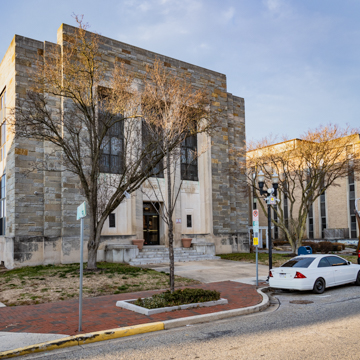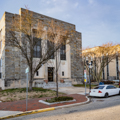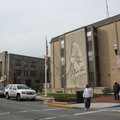By the early 1930s, Cecil County had outgrown its courthouse in part because of the paperwork generated by Elkton’s popularity as a wedding location. New Deal public works funding was utilized to build this stylish modern classical replacement designed by a Salisbury firm and built about two hundred yards from the previous courthouse. Faced with random ashlar Port Deposit granite, the new courthouse attempted to combine contemporary design with local materials, to decidedly mixed reviews. In Maryland Main and the Eastern Shore (1942) writer Hulbert Footner viewed the building as “hopelessly out of character with the simple, pleasant American town that surrounds it,” while officials were clearly interested in making a statement of modernity. The courthouse complex was expanded into a roughly H-shaped footprint with the 1960s construction of new county buildings to the east that, with the courthouse, framed a small landscaped plaza facing Main Street. Today the courthouse provides an unexpected but attractive touch of 1930s aesthetics in downtown Elkton, which is characterized by a mix of low-scale historic buildings and generic twentieth-century infill that replaced Main Street structures destroyed in a 1947 fire. The old courthouse was demolished, but portions of its courtroom were reused in the low, mid-twentieth-century expansion of Elkton Town Hall (108–112 North Street) that also incorporates the c. 1890s fire station that formerly housed town offices on the second floor.
You are here
CECIL COUNTY COURTHOUSE
If SAH Archipedia has been useful to you, please consider supporting it.
SAH Archipedia tells the story of the United States through its buildings, landscapes, and cities. This freely available resource empowers the public with authoritative knowledge that deepens their understanding and appreciation of the built environment. But the Society of Architectural Historians, which created SAH Archipedia with University of Virginia Press, needs your support to maintain the high-caliber research, writing, photography, cartography, editing, design, and programming that make SAH Archipedia a trusted online resource available to all who value the history of place, heritage tourism, and learning.






















